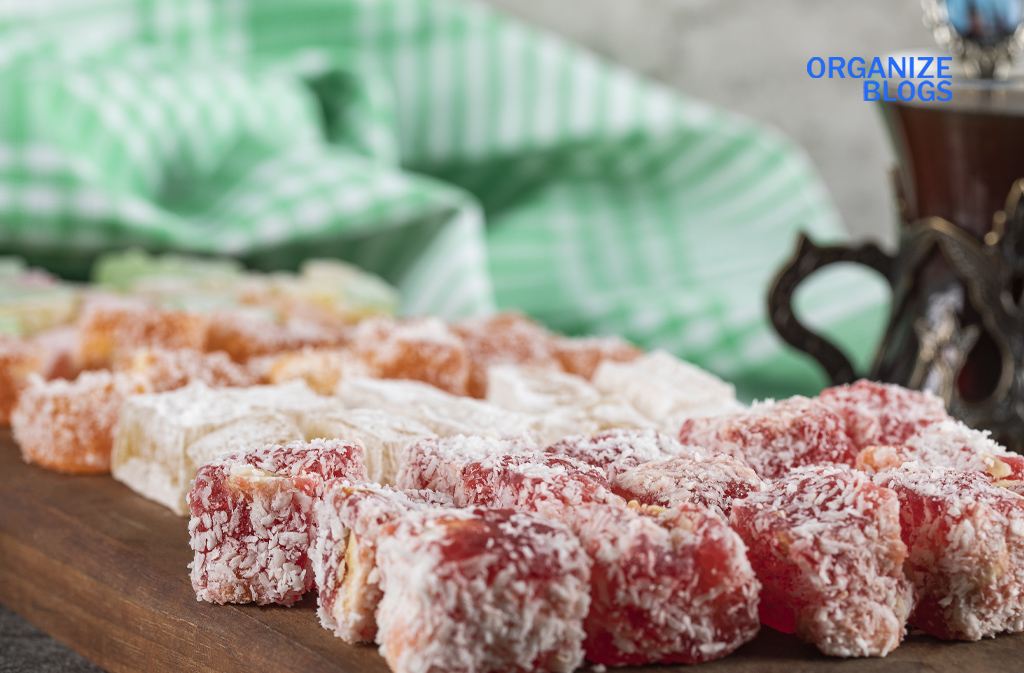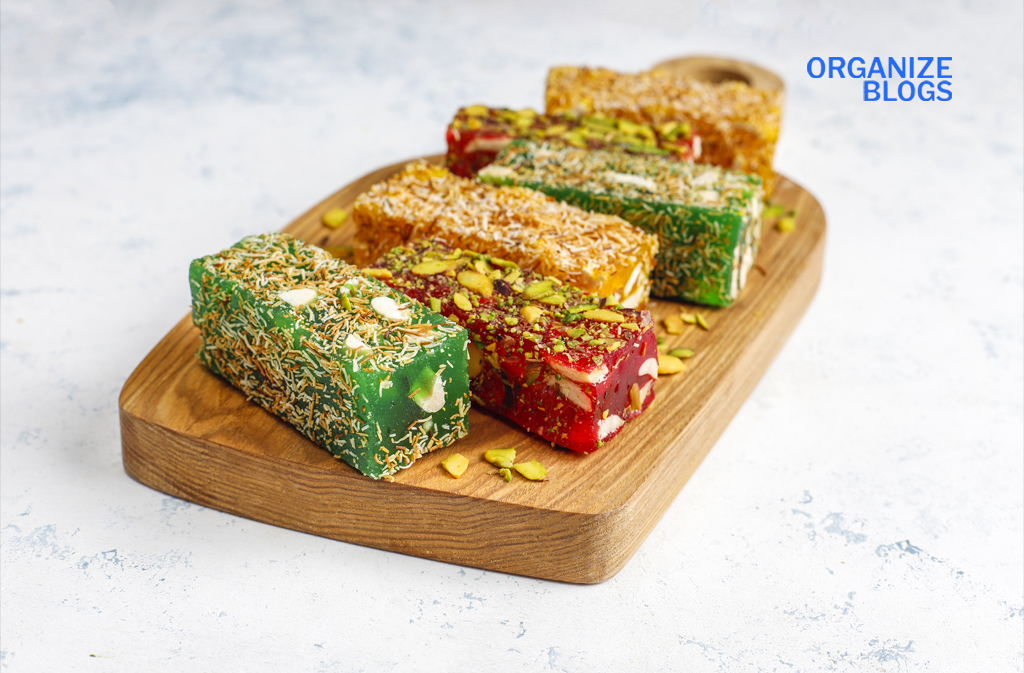Turkish delight is a soft, chewy candy that has been enjoyed for centuries. This colorful and flavorful dessert is a symbol of Turkish culture and hospitality. People love it for its delicate sweetness, gentle floral or citrus notes, and melt-in-the-mouth texture. Whether you try it in a market in Istanbul or make it at home, this treat leaves a lasting impression.
Over the years, Turkish delight has gained popularity worldwide. It’s often given as a gift, served with tea or coffee, or enjoyed as a special snack. With a wide variety of flavors, from rose to lemon, it appeals to both kids and adults. Making it may seem tricky at first, but with a candy thermometer, the right ingredients, and some patience, you can create a batch of this delicious candy yourself.
Table of Contents
The History of Turkish Delight
The origins of Turkish delight go back to the Ottoman Empire in the 18th century. A candy maker named Bekir Effendi is said to have perfected the recipe in Istanbul. His shop quickly became famous, attracting locals and foreign visitors alike. Since then, the candy has become a beloved tradition in Turkish households.
Interestingly, the treat became popular in Europe in the 19th century when travelers brought it back as a sweet souvenir. It was even featured in classic literature, which helped spread its fame. Today, you can find it in markets, specialty shops, and even supermarkets around the globe.
Ingredients That Make Turkish Delight Special
Making Turkish delight requires simple yet specific ingredients. The base usually includes sugar, water, and a cornstarch mixture to create the chewy texture. To enhance flavor, many recipes add lemon juice or rosewater. Cream of tartar helps stabilize the candy during cooking. For color, natural or artificial food coloring is used.
One essential step is dusting the finished pieces with powdered sugar to prevent them from sticking. The result is a soft, fragrant square of candy that looks as good as it tastes. This combination of ingredients gives the treat its signature smooth texture and subtle sweetness.
How to Make at Home
Step-by-Step Process
To make Turkish delight at home, first prepare your cornstarch mixture and set it aside. Next, boil sugar and water in a saucepan, adding lemon juice and cream of tartar. Use a candy thermometer to ensure the syrup reaches the right temperature, usually around 240°F (soft-ball stage).
Once the syrup is ready, gradually mix in the cornstarch base. Stir continuously until it becomes thick and golden. Add your chosen flavor and food coloring, then pour the mixture into a greased pan. After cooling, cut into squares and coat them in powdered sugar. Your homemade Turkish delight will be ready to enjoy!
Tips for Success
Consistency is key when making this candy. Always keep an eye on the temperature, and stir gently to avoid lumps. Using fresh ingredients and accurate measurements ensures the perfect chewy texture. While it may take a couple of tries to master, the reward is worth it—a batch of sweet, fragrant candy that rivals any store-bought version.
Popular Flavors of Turkish Delight
Turkish delight comes in a variety of flavors. The most famous is rose, which gives the candy its classic floral aroma. Lemon is another favorite, offering a bright and tangy taste. Pistachio and walnut varieties add a nutty crunch, while pomegranate provides a fruity twist.
Modern versions experiment with chocolate coatings, exotic spices, and even dried fruits. This variety ensures that there’s a flavor for everyone. Whether you prefer traditional rose or a modern chocolate-pistachio combo, Turkish delight remains a versatile and delightful treat.

Serving and Enjoying Turkish Delight
Traditionally, Turkish delight is served with tea or strong Turkish coffee. It can also be enjoyed as an after-meal dessert or a mid-day snack. The candy’s bright colors and elegant presentation make it perfect for festive occasions like weddings, holidays, and family gatherings.
Because it’s so eye-catching, many people use Turkish delight as a gift. Packed in a decorative box and dusted with powdered sugar, it feels special and luxurious. Whether shared with friends or savored alone, it’s a treat that brings a smile.
Health and Storage Tips
While Turkish delight is delicious, it’s best enjoyed in moderation due to its sugar content. The candy is naturally gluten-free, thanks to its cornstarch base, but always check labels if you have allergies. Homemade versions allow you to control sweetness and use natural food coloring for a healthier option.
Store the candy in an airtight container at room temperature. If kept away from moisture, it can last for several weeks without losing its texture. Avoid refrigerating it, as this can make it too firm and affect its chewiness.
Why Turkish Delight Remains a Timeless Treat
Turkish delight has stood the test of time because it combines tradition, flavor, and beauty. It carries with it centuries of history while continuing to adapt to modern tastes. From its origins in the Ottoman Empire to kitchens around the world, it has always been more than just candy—it’s a symbol of hospitality and joy.
Whether you buy it from a shop or make it at home, Turkish delight connects you to a rich cultural heritage. Its charm lies not only in its taste but also in the memories and stories it carries. That’s why it remains a favorite across generations.
Conclusion
Turkish delight is more than a sweet snack—it’s a piece of history wrapped in powdered sugar. With simple ingredients like cornstarch mixture, lemon juice, cream of tartar, food coloring, and powdered sugar, you can recreate this treat at home. By following the right steps and using a candy thermometer, you can enjoy a homemade version that’s as good as the ones found in Turkish bazaars.
Its soft texture, rich flavors, and vibrant colors ensure that Turkish delight will always have a place in the hearts of candy lovers. Whether served at a celebration, enjoyed with coffee, or given as a thoughtful gift, it’s a timeless dessert that’s here to stay.

Frequently Asked Questions
1. What is Turkish delight made of?
Turkish delight is made with sugar, water, a cornstarch mixture, and flavorings like rosewater or lemon juice. Cream of tartar is often added to stabilize the mixture, and powdered sugar is used to coat the finished pieces.
2. Is hard to make at home?
It’s not difficult, but it requires patience and accuracy. You’ll need a candy thermometer to get the sugar syrup to the correct temperature and to achieve the right chewy texture.
3. What flavors of Turkish delight are most popular?
Rose and lemon are the classic flavors, but you can also find varieties with pistachios, walnuts, pomegranate, and even chocolate-coated versions.
4. How do you store Turkish delight?
Store it in an airtight container at room temperature. Keep it away from moisture to prevent it from becoming sticky. Avoid refrigeration, as it can make the candy too firm.
5. Is gluten-free?
Yes, traditional Turkish delight is naturally gluten-free because it uses cornstarch instead of wheat flour. However, always check labels for added ingredients if you have dietary restrictions.
Visit our website: Organize Blogs

